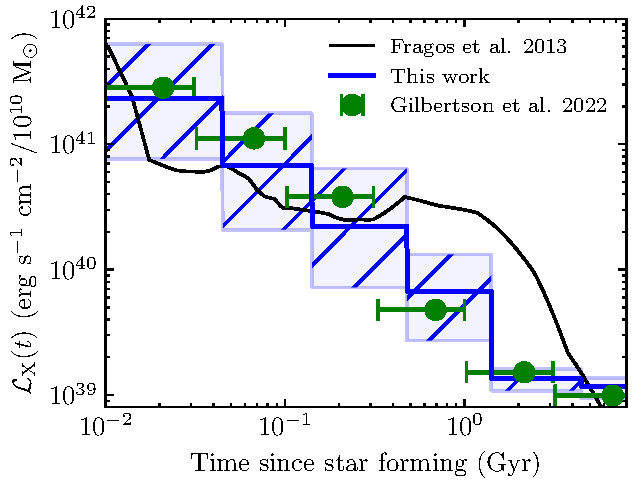A joint research team led by the Department of Astronomy at Tsinghua University and the Purple Mountain Observatory (PMO) of the Chinese Academy of Sciences has conducted the most comprehensive X-ray survey to date of our neighboring galaxy, Andromeda (M31), using the European Space Agency’s (ESA) XMM-Newton space telescope. The study reveals that the total X-ray luminosity of Low-Mass X-ray Binaries (LMXBs) in M31 is significantly lower than theoretical expectations. Contrary to standard models predicting a "plateau" of high luminosity lasting up to a billion years, the researchers discovered that these systems undergo a continuous and rapid decline shortly after formation. This "premature fading" means that by the time these systems are about 1 billion years old, their actual observed luminosity is far below theoretical predictions. This discovery challenges the long-held "universal" empirical relation that X-ray luminosity is proportional to stellar mass, as well as current evolutionary models for low-mass X-ray binaries. The findings have been accepted for publication in the prestigious journal Monthly Notices of the Royal Astronomical Society (MNRAS).

Figure 1: An X-ray and Infrared Portrait of Andromeda. This false-color composite merges X-ray data from XMM-Newton (blue/white points) with infrared data from WISE (orange dust lanes). Bottom: The complete footprint of the New-ANGELS survey, covering the galaxy from its center out to the halo. Top: A close-up of the galactic disk, where X-ray binaries appear as brilliant gems embedded within the galaxy structures indicated by infrared emission.
The Clearest X-ray "Census" of Andromeda
X-ray binaries, consisting of a compact object (a neutron star or black hole) and a companion star, serve as "cosmic laboratories" for studying stellar evolution under extreme gravity and are crucial "fossils" for tracing the evolutionary history of galaxies. While we reside within the Milky Way, dust obscuration and distance uncertainties make it difficult to obtain a complete view of Galactic X-ray sources. In contrast, the Andromeda Galaxy (M31), as the nearest massive spiral galaxy, offers a pristine, panoramic view with well-determined distances, making it the ideal site for a census of stellar-mass X-ray sources.
As part of the XMM-Newton Legacy Survey of M31 (New-ANGELS), the team utilized the telescope's large field of view and high sensitivity to map a vast area of 7.2 square degrees, covering the galaxy's disk and its surrounding halo. The survey detected 4,506 X-ray sources. By meticulously modeling and subtracting background active galactic nuclei and foreground stars, the team constructed the largest and cleanest catalog of X-ray sources in M31 to date.
The "Premature Fading" of X-ray Binaries

Figure 2: Ideal "Stable" vs. Realistical "Fading". A comparison of the luminosity evolution of X-ray binaries. Black Line (Theory): Traditional models predict a high-luminosity "plateau" lasting up to a billion years. Blue Line (This Work): The study reveals a continuous and rapid decline in brightness immediately after formation. The "missing plateau" explains why X-ray binaries at ~1 billion years old are observed to be much dimmer than predicted.
By constructing X-ray luminosity functions for different regions of M31 (including the bulge, inner arm, and outer disk), the team systematically compared the properties of source populations. The results show that while LMXBs dominate the galaxy's X-ray emission, their integrated luminosity per unit stellar mass is consistently lower than that of other galaxies. This is particularly evident in the "Inner Arm" region, dominated by stellar populations aged 2–4 billion years, where X-ray emission is anomalously dim. Combining this with an analysis of M31’s star formation history, the researchers found a striking discrepancy with theoretical predictions. While models predict that X-ray luminosity should maintain a "plateau" for roughly a billion years, the observational data reveals a continuous and rapid decay immediately after formation of XRBs. At an age of ~1 Gyr, the observed luminosity is significantly lower than the model prediction.
These results indicate that low-mass X-ray binaries do not maintain a constant, high luminosity, but rather 'age' gradually after formation, with their luminosity at 1 billion years falling far below theoretical expectations. This implies that a galaxy's star formation history has a much more complex impact on its overall X-ray emission, rather than the latter being simply proportional to total stellar mass.
Rethinking the "X-ray Luminosity Formula"
For decades, astronomers have used a galaxy's stellar mass to estimate its total X-ray luminosity—known as the "$L_X - M_*$ relation." However, the results from M31 suggest this empirical law breaks down in galaxies with specific star formation histories. The overall lower than expected luminosity of M31's X-ray sources can be attributed to its older stellar population and the fact that its LMXBs have already entered this "premature fading" phase. This finding provides a new benchmark for calibrating theoretical models and offers a crucial reference for understanding the long-term evolution of binary systems in the Milky Way and beyond.
Collaborators and Funding
The study was led by Dr. Rui Huang, a postdoc at Tsinghua University, currently visiting the University of Michigan. The corresponding author is Prof. Jiang-Tao Li from the Purple Mountain Observatory. Key collaborators include Prof. Wei Cui and Assistant Prof. Zhijie Qu from Tsinghua University, Prof. Joel Bregman from the University of Michigan. Prof. Gabriele Ponti from the Max Planck Institute for Extraterrestrial Physics and the INAF–Brera Astronomical Observatory, Prof. Xiangdong Li from Nanjing University, and Prof. Daniel Wang from the University of Massachusetts. This work was supported by the National Natural Science Foundation of China, the China Manned Space Program, and the Ministry of Science and Technology of China.
Paper Link: https://arxiv.org/abs/2511.05856

